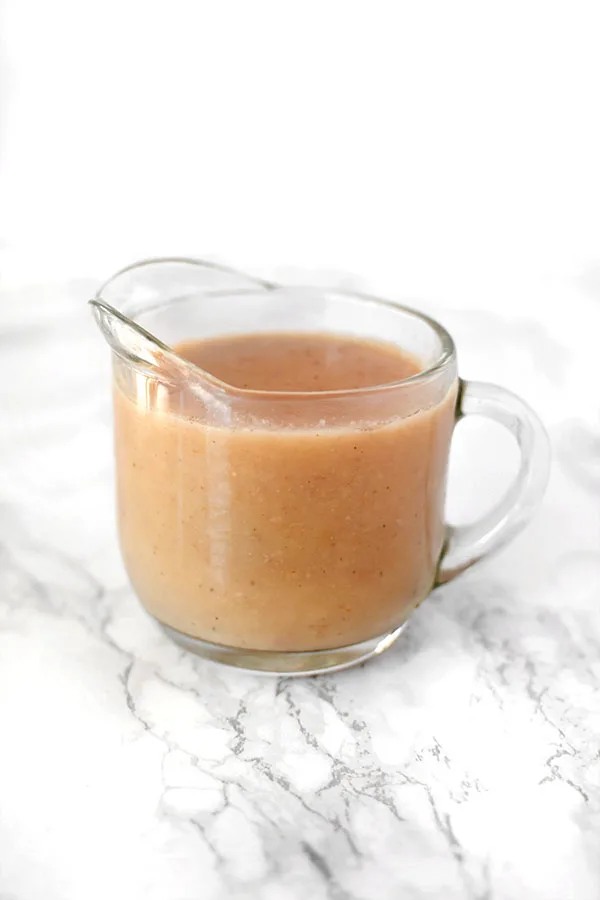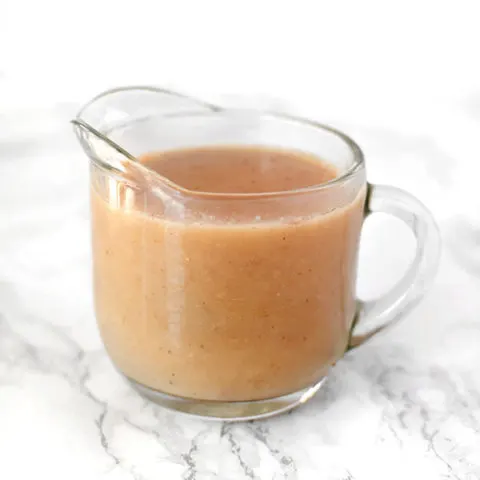This dairy free gravy is made without milk, without butter, and without cream. It is also very easy to make and perfect for any family or holiday dinner!

This dairy free gravy is your classic pan gravy or brown gravy, which is served over mashed potatoes, poultry, and meat.
The main time of year I make gravy is Thanksgiving. Thanksgiving is my favorite holiday and pull out all of the stops, from the dairy free turkey to the dairy free pumpkin pie.
However, this dairy free gravy can be made any time of year using whatever stock you want and using either flour or starch.
My personal favorite year-round meal to make with this dairy free gravy is dairy free fried chicken with mashed potatoes and gravy.
You may also like country gravy, which is used for recipes like biscuits and gravy.
If you don't have drippings or would rather not use them, check out my recipe for dairy free gravy without drippings.
What type of stock to use
Generally, the type of gravy depends on the type of meat or poultry you roasted because it is made from the incredibly flavorful pan drippings.
Likewise, you'd use the same type of stock. If you're using the gravy over beef, you use a beef stock, and a chicken gravy would call for a chicken stock.
For turkey gravy, you can use chicken stock instead of turkey stock if that is what you have on hand or is easy for you to get.
The color of the gravy will greatly depend on the color of the stock. Chicken and turkey stock are lighter than beef stock.
Some feel beef gravy has better color while chicken gravy has better flavor. If you want the best of both worlds, use half beef gravy and half chicken gravy.
Bullion Powder and Cubes
Bullion powder and bullion cubes work fine for making stock.
In addition to beef and chicken bullion, there are vegetarian bullion powders that can work here as well.
Mushroom or onion bullion powder works well with beef, whereas vegetable stock and vegetarian chicken stock are good for chicken and turkey.
I always have onion bullion powder and vegetarian chicken bullion powder on hand because they are common in Israeli kitchens. So, I've used them often in recipes, including gravy, instead of stock.
Stock vs water
I personally like using stock because it adds flavor. However, it is not uncommon for people to use water to make gravy.
STOCK VS. BROTH
Broth is usually thinner and made from meat, while stock is made from simmering bones for a long time.
Stock is usually thicker and has a richer mouth feel from the gelatin releases from the long-simmered bones.
Adding onions, carrots, celery, bay leaves, and other herbs add to the flavor of the stock.
WHAT ABOUT STORE-BOUGHT STOCKS AND BROTHS?
Commercial brands tend to use the terms “stock” and “broth” interchangeably, and store-bought stocks and broths are usually more broth than stock.
They tend to be lightly flavored, lack the body of a homemade stock, and they result in a less flavorful dish.
HOW STOCKS AND BROTHS ARE MADE
Broths and stocks are also made differently.
Stocks are typically made from meaty raw bones, leftover carcasses, and meat and vegetable scraps. In the case of vegetable stock, only vegetables are used.
Stocks are simmered for several hours (unless you make pressure cooker stocks) to extract as much of the flavor from the ingredients as possible. This also extracts collagen from the bones and cartilage, which adds body and silkiness to the stock.
Broths are usually much lighter and have less body than stocks.
They’re most often made from poaching meat, vegetables, and seasonings in water for as long as it takes for the meat to cook or the broth to pick up some flavor.
HOW STOCKS AND BROTHS ARE USED
In classic French cuisine, stocks are considered to be an ingredient that’s used to make other things.
Also, they’re typically left unseasoned or only minimally seasoned so that they can be used in as wide a variety of ways as possible.
Stocks can be used to make soup, reduced into a sauce or a glaze, or as an ingredient in many recipes.
Broths, on the other hand, have been salted, which restricts the ways they can be used.
For the most part, broths are consumed on their own or used as a base for soups, like chicken soup.
This definition of stocks as an ingredient and broths as a food product is the way classically trained chefs tend to think about such things in their restaurant kitchens.
Why Use Flour to Thicken Gravy
I use flour to thicken gravy because it gives the gravy that classic opaque, slightly pale look.
Many people don't like using flour because if it isn't cooked long enough, it can give a floury flavor to the gravy. Also, if not made properly, it can become clumpy.
The good news is, making a smooth, creamy gravy is a snap if you turn it into a roux first.
Another benefit some people see with gravy made with flour is that it keeps better in the fridge. This means it can be made ahead of time or used for leftovers.
Why use Starch to Thicken Gravy
Both corn starch and potato starch can be used to make a gravy.
Gravy made with starch is considered by many to have a silkier texture than gravy made with flour.
This option is perfect for anyone who is gluten-free (make sure the package is marked gluten-free).
Just like with the gravy made using flour needs a roux to avoid clumping, gravy made using starch needs a slurry.
Gravy made with starch is clearer, darker, and shinier than gravy made using flour.
Cornstarch vs cornflour
Cornstarch and cornflour are the same thing. In North America, cornstarch is the term commonly used, whereas in Europe it is referred to as cornflour.
Potato Starch and other starches
This recipe calls for cornstarch just because it is the most common. However, you can use potato starch or any other starch you have on hand.
Potato Starch vs Potato Flour
Potato flour is made from whole peeled potatoes, cooked, dried, and ground into a fine, beige-colored powder.
Potato starch, on the other hand, is “washed” out of crushed potatoes, then dried to a fine, bright-white powder.
Potato flour is great for adding moisture and flavor to breads, while potato starch is the right choice for gravy.
What is a Roux
A roux is equal parts flour and fat cooked together until it reaches a specific color.
It is used as a thickening agent for gravy, sauces, soups, and stews, and it has been used in French cooking for hundreds of years to thicken sauce.
The flour is added to the melted fat or oil on the stove top, blended until smooth, and cooked to the desired color.
A roux can be white and used for country gravy, blond for classic gravies, or brown and used in gumbo and jambalaya.
The lighter the roux, the more thickening power it has.
Once the roux is the desired color, liquids like stock are added.
What is a Slurry
Slurries are commonly used in Asian cooking and Chinese-American cuisine. It is used to make sauces needed for recipes like Beef and Broccoli and Pepper Steak.
A slurry, like a roux, is used to thicken gravies, sauces, stews, and soups. However, unlike a roux, it is added at the end of the recipe.
It is a combination between corn starch or potato starch and water and provides a silky texture.
While it is less common, slurries can be made out of flour.
How to use flour and starch
If you want both the benefits of the flour and the starch, you can use both.
To do this, use 2 tablespoons of flour and drippings to make a roux. After the stock is added, use one tablespoon of starch to make a slurry and slowly add it to the sauce.
Drippings
Drippings are what you find at the bottom of a roasting pan. Usually, there is less than a cup left, so stock or water are added until you have 2 cups.
This recipe only calls for ¼ cup of drippings because you're almost definitely going to have that much. However, I personally like using as much drippings as possible because they have so much flavor.
Deglazing The Pan
Deglazing a pan involves adding liquid, such as stock or wine, to a pan. Then, a wooden spatula is used to loosen and dissolve bits, known as fond, that are stuck to the bottom after cooking or searing.
Fond is a great source of flavor and mixture produced by deglazing and can be used to make a sauce. This is a great way to add flavor to your gravy.
What to do if you don't have enough fat drippings
If you collect the fat drippings from the bottom of the roasting pan and find you don't have enough for this recipe, don't worry.
All you have to do is add more fat until you have the right amount.
This can be animal fat like schmaltz or a neutral oil.
Can it be made ahead of time?
Yes. You can make this gravy a day or two before and simply reheat it shortly before you're ready to serve.
How to Store
Once the gravy has cooled, place it in an airtight container. Keep for up to 5 days in the refrigerator.
How to Freeze
Once the gravy has cooled, place it in an airtight container or a resealable freezer bag.
You can freeze gravy for up to 5 months. After that, it is still safe to eat, but the quality begins to degrade.
How to Reheat
Gravy will thicken as it cools. When you reheat it, thin it out with additional stock until it is smooth and reaches your desired consistency again.
Dairy Free Gravy

This dairy free gravy is an easy classic brown gravy made without milk, without butter, and without cream.
Ingredients
- ¼ cup fat drippings
- ¼ cup flour or 2 tablespoons starch
- 3 to 4 cup stock
- 1 teaspoon onion powder
- ½ teaspoon garlic powder
- Salt
Instructions
Gravy Made with Flour
1. Heat with the fat drippings over a medium heat.
2. Add flour to make the roux. Stir constantly with a spatula or a whisk until it has a light brown color. About 6 or 7 minutes.
3. Slowly pour in half a cup to a cup of the stock while whisking vigorously. Add the remaining stock slowly and as needed.
4. Reduce to a simmer and cook for a few minutes, until the gravy reaches your desired consistency.
5. Mix in onion powder, garlic powder, and salt to taste.
6. Remove from flame and serve.
Gravy with Corn or Potato Starch
- Whisk cornstarch and ¼ cup of stock, adding a little stock at a time to make a slurry.
- Place the roasting pan on the stove on medium high heat.
- Add stock to the pan and scrape up any drippings that are sticking to the pan. Whisk in the slurry.
- Bring to a simmer. Mix in onion powder, garlic powder, and salt to taste.
- Once thick, remove from the flame and serve.
Nutrition Information:
Yield:
8Serving Size:
1Amount Per Serving: Calories: 145Total Fat: 4gSaturated Fat: 1gTrans Fat: 0gUnsaturated Fat: 3gCholesterol: 11mgSodium: 588mgCarbohydrates: 16gFiber: 0gSugar: 6gProtein: 10g